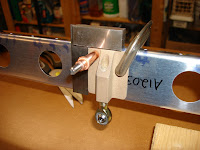Time for another blog update. It's obvious that I am not a good blogger but I hope I am a better airplane maker. I have made good progress these last ten weeks. Here are some photos of construction of the empennage. The bird finally has tail feathers and is starting to look like an airplane.
The bird finally has tail feathers and is starting to look like an airplane.
 The bird finally has tail feathers and is starting to look like an airplane.
The bird finally has tail feathers and is starting to look like an airplane.This photo of the anti-servo tab used for trim on the stabilator indicates the quality of the design of this plane. I've flown two other planes with this design, a Piper Warrior and a CT and I always wondered how they worked. Now I know.
 The tail cone is being joined to the fuselage. This looks exactly like a photo taken in the Boing plant when they join the fuselage together for the 747, except a little smaller. My workforce is smaller too.
The tail cone is being joined to the fuselage. This looks exactly like a photo taken in the Boing plant when they join the fuselage together for the 747, except a little smaller. My workforce is smaller too. The fitting of the polycarbonate turtle deck back light. This started out to be very difficult until I remembered other bloggers stating that working with the canopy is safer and easier if the environment was warm. I inserted an electrical resistance heater in the baggage compartment and let the temperature stabilize around 99 F and over a three hour period, gradually inserted the clecoes until all of the holes lined up. Then match-drilled the roll bar, removed the polycarbonate and tapped the numerous holes to a 6-32 thread. My consummate skill as a lay machinist was at it's peak until I broke the tap off with only three holes to go. Luckily I was able to break the tap out and salvage the threaded hole. The bloggers also expressed concern about drilling holes in the polycarbonate. It has a tendency to fracture if the correct drill bit or technique is not used. I did purchase a special drill bit for drilling plastics and also brought an old hand powered drill at an antique show last month. The combination of those allowed a successful completion of enlarging the holes in the polycarbonate.
The fitting of the polycarbonate turtle deck back light. This started out to be very difficult until I remembered other bloggers stating that working with the canopy is safer and easier if the environment was warm. I inserted an electrical resistance heater in the baggage compartment and let the temperature stabilize around 99 F and over a three hour period, gradually inserted the clecoes until all of the holes lined up. Then match-drilled the roll bar, removed the polycarbonate and tapped the numerous holes to a 6-32 thread. My consummate skill as a lay machinist was at it's peak until I broke the tap off with only three holes to go. Luckily I was able to break the tap out and salvage the threaded hole. The bloggers also expressed concern about drilling holes in the polycarbonate. It has a tendency to fracture if the correct drill bit or technique is not used. I did purchase a special drill bit for drilling plastics and also brought an old hand powered drill at an antique show last month. The combination of those allowed a successful completion of enlarging the holes in the polycarbonate. There she is, empennage kit complete. The wings, fuselage and empennage kits basically complete the structure of the airplane. The finishing kit has been ordered with expected arrival about 4-6 weeks. Then there is the avionics kit and the engine kit. Total build time to date has been 542 hours. Van's indicates about 600-900 hours to build sans paint. I won't make the 600 mark but might make the 900 mark.
There she is, empennage kit complete. The wings, fuselage and empennage kits basically complete the structure of the airplane. The finishing kit has been ordered with expected arrival about 4-6 weeks. Then there is the avionics kit and the engine kit. Total build time to date has been 542 hours. Van's indicates about 600-900 hours to build sans paint. I won't make the 600 mark but might make the 900 mark. It would be sweet to fly to Oshkosh next July...

























